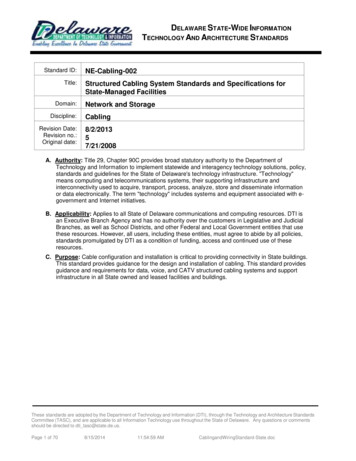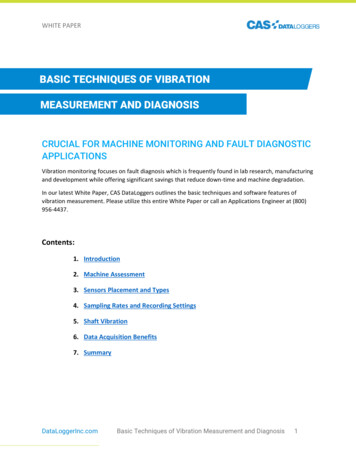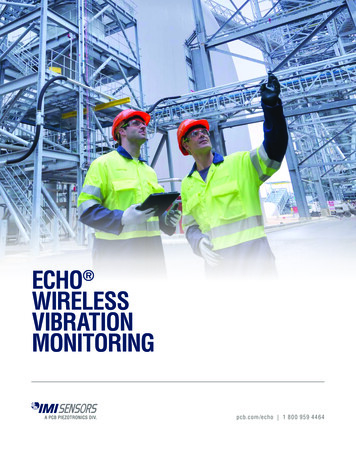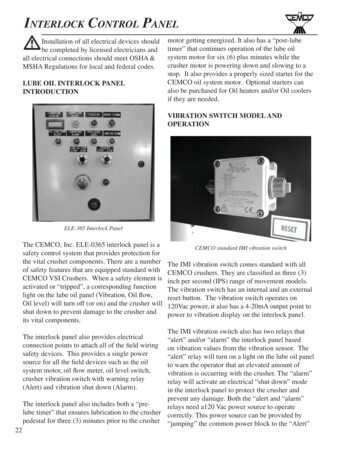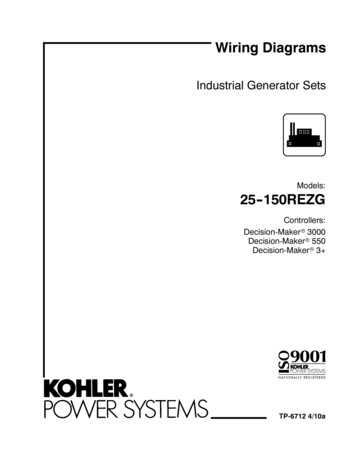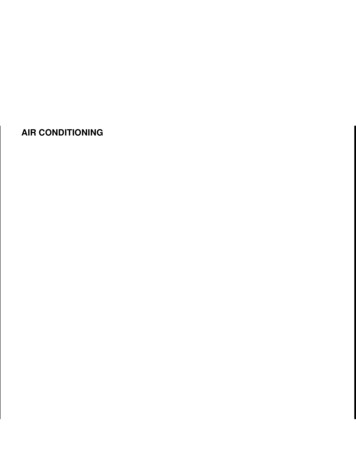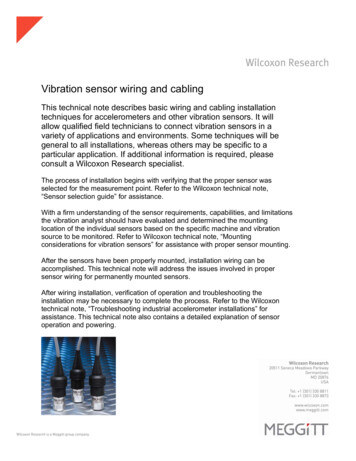
Transcription
Vibration sensor wiring and cablingThis technical note describes basic wiring and cabling installationtechniques for accelerometers and other vibration sensors. It willallow qualified field technicians to connect vibration sensors in avariety of applications and environments. Some techniques will begeneral to all installations, whereas others may be specific to aparticular application. If additional information is required, pleaseconsult a Wilcoxon Research specialist.The process of installation begins with verifying that the proper sensor wasselected for the measurement point. Refer to the Wilcoxon technical note,“Sensor selection guide” for assistance.With a firm understanding of the sensor requirements, capabilities, and limitationsthe vibration analyst should have evaluated and determined the mountinglocation of the individual sensors based on the specific machine and vibrationsource to be monitored. Refer to Wilcoxon technical note, “Mountingconsiderations for vibration sensors” for assistance with proper sensor mounting.After the sensors have been properly mounted, installation wiring can beaccomplished. This technical note will address the issues involved in propersensor wiring for permanently mounted sensors.After wiring installation, verification of operation and troubleshooting theinstallation may be necessary to complete the process. Refer to the Wilcoxontechnical note, “Troubleshooting industrial accelerometer installations” forassistance. This technical note also contains a detailed explanation of sensoroperation and powering.
asdfElectrical powering requirementsMost internally amplified vibration sensors require a constant current DC powersource. Generally, the power supplycontains an 18 to 30 Volt source with a 2to 10 mA constant current diode (CCD)(see Figure 1). If other powering schemesare used, consultation with the sensormanufacturer is recommended. A morethorough discussion of poweringrequirements follows.Figure 1: Amplitude range versus supply voltageAC coupling and the DC bias voltageThe sensor output is an AC signal proportional to the vibration applied. This ACsignal is superimposed on a DC bias voltage also referred to as bias outputvoltage (BOV) or rest voltage. The DC component of the signal can be blockedby a capacitor thereby leaving the AC output signal. Most vibration datacollectors, monitors, and sensor power units contain an internal blockingcapacitor for AC coupling.Amplitude range and the supply voltageThe sensor manufacturer usually sets the bias voltage at half the nominal supplyvoltage. The difference between the bias and cutoff voltages determines thevoltage swing available at the output of the sensor. The output voltage swingdetermines the peak vibration amplitude range (see Figure 1). Thus anaccelerometer with a sensitivity of 100 mV/g, and a peak output swing of 5 Volts,will have an amplitude range of 50 g peak. Some accelerometers may be able toachieve a larger voltage swing than the 5 Volts normally assumed. Consult withyour sensor manufacturer for details of the voltage swing permitted for the sensorunder consideration. If a voltage source lower than 18 Volts is used, theamplitude range will be lowered accordingly. Custom bias voltages are availablefor lower or higher voltage supply applications.Constant current diodes (CCD)Virtually all internally amplified vibration sensors require power supplies that areregulated by a CCD. The CCD limits the current supplied to the sensor. The useof unlimited power supply current will damage most internally amplified sensors.For this reason, most commercially available data collectors and vibrationasdf
asdfmonitors have power supply circuits that include a CCD to regulate the powersupplied to the sensor. The power supplied is almost always in the 2 - 10 mArange. Most battery power supplies contain a 2 mA CCD to ensure long batterylife. Line powered supplies (where power consumption is not a concern) shouldcontain 6 to 10 mA CCDs to drive long cables. For operation above 100 C, limitthe current to less than 6 mA to reduce overheating of the accelerometer’sinternal amplifier. Common CCD’s used are the J500 Series (J507, J509) fromVishay Siliconix. The CCD should be placed in series with the voltage output ofthe supply while making sure that proper diode polarity is observed!Cabling requirementsCabling is one of the most important aspects of vibration sensor installation.Careful attention must be given to four major considerations: cable length andcapacitance, routing, grounding, and anchoring.Driving long cablesModern industrial piezoelectric sensors are, typically, voltage mode devices. Thatis, they produce a voltage dependent on the vibration signal being measured.This vibration signal voltage is an Alternating Current (AC) voltage and, as such,is subject to all the limits of AC signals. High frequency AC signals are affectedby the capacitance in AC circuits causing capacitive reactance. While manyusers may feel that vibration signals are not high frequency, compared to radiofrequency signals, these signals are still affected by the capacitive reactance incircuits.What does this mean to users of voltage-mode vibration sensors? When cablesbetween the sensor power supply and the sensor are short (under 30 meters),circuit capacitance will usually have no noticeable effect upon the vibration datasignals. But, long cables will likely introduce sufficient capacitance into the sensorcircuit to allow the vibration signal to develop distortion and, hence, producespurious signals. This additional capacitance creates a capacitive load on theoutput of the sensor’s amplifier. The amplifier has the ability to sink fairly largeamounts of current, but cannot provide an indefinite amount of current for drivingcapacitance.asdf
asdfIn the circuit of figure 2, the CCD mustprovide all of the current to charge thecapacitance of the cable when the signalvoltage is positive. Each cycle of an ACsignal being produced by the sensor’samplifier must have sufficient currentavailable to adequately drive the cablecapacitance. The amplifier itself needsapproximately 1 mA of current availablefor its own use. When the current needsof the on-board amplifier combined withthe current required to drive the cable areFigure 2: Sensor output equivalent circuitinsufficient, the amplifier output voltagewill become “slew rate limited.” In apractical sense this means that the output signal, for an AC sinusoid, will not beable to accurately reflect the true signal.Figure 3: Slew rate limited signalFigure 3 is an illustration of a slew rate limited sinusoid. The positive-going part ofthe sine wave signal is being limited by the current available to drive the signalinto the cable. It becomes a “straight” line because of the limited current availableto drive the cable capacitance. During the negative-going portion of the sinewave, the amplifier must “sink” or “soak up” the current being discharged by thecapacitor. The amplifier is far more capable at absorbing this discharge current,so the limiting factor in high frequency operation becomes the ability of the CCDto provide the necessary current to charge up the cable capacitance.When the current limitation point is reached, it is only the positive going portion ofthe signal that is affected. The practical effect of this condition is that the signalactually becomes distorted and harmonics are generated. This could lead tovibration signals being misinterpreted as having strong harmonic componentswhen they, in fact, do not have such harmonics present. In the extreme case, thesignal waveform will actually start to resemble a triangle waveform. Trianglewaveforms have strong harmonic components at all multiples of the fundamentalfrequency.asdf
asdfComputing the maximum frequencyThe current through a capacitor is determined by the following differentialequation:I Cdv(t)dtWhere v(t) V sine ωt, and ω 2πf with f being the frequency of interest and Vthe peak voltage.Differentiating the v(t) function yields the following:dv(t) Vω cos ωtdtorI CV(2πf) cos (2πf)tHowever, since we are only looking at the current required to meet the peakvoltage we must evaluate this equation at the point where the value is at its peak.The voltage is at its peak when cos ωt 1. Now the equation for determining thelimiting frequency looks like this:I CV(2πf)Where I is the current required for the capacitor.But the current required for the capacitor is only part of the total current. Theequation for the total current in the circuit is expressed by the following:Iccd I 1 mAWhere Iccd is the current supplied by the constant current supply and 1mA is needed for powering the on-board electrics of the sensor.Rearranging the equation yields:I Iccd – 1 mACombining these equations results in the following:Iccd – 1 mA CV (2πf)asdfBy rearranging the terms to solve for the frequency, f, we get this equation:f Iccd – 1 mA2 π(C)(V)This is the equation that will yield the frequency limit. However, we will againrearrange these terms and add a scaling factor to allow the computation to beconducted in units typical for the application.
asdfComputing the maximum length for a cablefmax 109sd2π(C)(V) / (Iccd – 1 mA)Where, fmax maximum frequency (hertz)C cable capacitance (picofarads)V peak signal output from sensor (volts)Iccd constant current from signal conditioner109 scaling factor to equate unitsThis equation illustrates that when cable capacitance increases, either theconstant current value must increase or the maximum usable frequency mustdecrease to keep the equation in balance and avoid signal distortion.Figure 4: Cable length limits vs. frequency for various current drive levelsThe chart in figure 4 illustrates, graphically, the results of applying the formula forcable length limits. In this graph the maximum voltage swing was assumed to be5 Volts and the cable capacitance 30 picoFarads (30 pF) per foot. 5 Volts is onegenerally accepted swing used for computation of accelerometer dynamic rangewhile 30 pF/foot is a fairly common capacitance for Wilcoxon cables. As anexample, if the user wished to use an accelerometer with a 100 mV/g sensitivity,measuring vibration at up to 50g levels (50g x 100mV/g 5 Volts), powering theaccelerometer with a 4 mA constant-current source, and wanting to be able tomeasure signals at 10,000 Hz, how long could the cable be?Starting at the 10,000 Hz location at the chart bottom we can move up until weget to the 4 mA line. At that point we are just over 300 feet of cable length.asdf
asdfTherefore, under the conditions described above, the user could have up to 300feet of cable and make reliable vibration measurements.Amplitude overloadThe previous technical discussion basically means that high frequency highamplitude signals can produce signal distortion and cause false signals to appearat low frequencies. Other sources of high frequency overload could be gearimpacts or the broadband hiss of a steam release valve. Most WilcoxonResearch sensors are protected from moderate high frequency overloads by awashover filter.Powering sensor in higher temperaturesIn environments where sensor temperatures are at or above 100 C (212 F), thecurrent should be no more than 6 mA to prevent overheating damage to theaccelerometer’s internal amplifier.Cable routing and electromagnetic interferenceWalkie-talkies, power lines, and electrical sparks are sources of signalinterference. The following guidelines will eliminate many measurement errorsdue to electromagnetic interference (EMI) and electrostatic discharge (ESD).Assure that high quality, well-shielded cables are used. If cable splices are made,complete shielding should be maintained. Proper cable routing is alsorecommended. Avoid routing sensor cables alongside AC power lines; cablesshould cross AC power lines at right angles. Where possible, provide a separategrounded conduit to enclose the sensor cable. In addition, route the cable awayfrom radio transmission equipment, motors, generators, and transformers.Finally, avoid routing the cable through areas prone to ESD. Even though thesensor is protected against ESD failure, temporary signal distortion may occur asthe result of severe ESD.When running cables near electric motors, always have the cable approach themotor perpendicular to the motor rotor axis. The cables should always run directlyaway from the monitoring point and be maintained at the maximum distance fromthe motor case to avoid influence from the stator winding magnetic field. On DCmotors, the cable runs should be kept as far away from the brushes as ispractical to avoid the broadband radio frequency noise generated by the motorbrushes.asdf
asdfCable grounding and ground loopsIn instrumentation circuits, grounding performs a different function than inelectrical power wiring circuits. Electrical power wiring grounds are primarily forsafety, to prevent electrical shock by providing a barrier between high potentialwires and personnel. Electrical grounds also carry a portion of the current inmany installations. For electrical purposes, any proper ground is a good groundfor protection.Instrumentation circuits use grounds for shielding and protecting the sensitiveinstrumentation equipment from accidentally measuring noise and strayelectromagnetic fields as part of the signalbeing analyzed. In instrumentation, theonly proper ground is one that has noground loops, that is, there exists one,and only one, path to ground from anygrounded point in the instrumentationground system. This is often referred toas a ground tree, as it has thecharacteristic structure of a tree with nolimbs crossing or touching.Figure 5: Illustration showing improperInstrumentation circuits also have all theirgrounding in an accelerometer installation.wires encased in a shield to protect themfrom electromagnetic pickup. The shieldshould never be allowed to come intocontact with conduit walls or junctionboxes, otherwise an inadvertent groundloop will be created.When ground loops exist in instrumentation circuits, they allow currents to flowthrough the ground system. Any time there is a loop circuit in instrumentationwiring, current will be induced in that wire by any of the many sources ofelectromagnetic fields found around industrial equipment. These loop currentsflowing in the shield will cause electromagnetic coupling into the vibrationmeasurement circuit, as shown in figure 5. Power lines, motor stator fields, motorrotor fields, and radio frequency equipment are the normal sources withinindustrial installations.asdf
asdfAll on-line monitoring systems and other permanently connected instrumentationsystems have their own connection to the plant instrumentation ground.Instrumentation grounds should never be used for electrical power circuitgrounding. If used, they will generally result in compromising the integrity of theinstrumentation ground and inducing noise into the entire instrumentation system.The best cabling to use for vibration monitoring installations is shielded, twistedpair. These cables have two conductors that are twisted around each other forthe length of the cable. The conductors are twisted creating alternating wireloops,which when exposed to magnetic fields cancel the induced currents in the wires,reducing magnetic pickup. This same technique is used by thetelecommunication industry for telephone wiring. High voltage powertransmission lines are also twisted for similar reasons.Instrumentation shields used in vibrationmonitoring systems should beconnected only at one end of the cablerun. Figure 6 illustrates a shieldconnected at the data acquisitionequipment end of the cable, while beingisolated at the sensor end of theconnection.Another grounding possibility for theinstrumentation wiring would be toground the shield at the sensor end ofthe cable. This option is illustrated infigure 7. Do not connect the shield tothe ground at the data acquisitionequipment if the sensor end of the cableis grounded.When portable data collectors are usedto gather data from permanentlymounted vibration sensors, the groundissue is not as critical. The portable datacollector has its own internal referencethat is used for the circuit common.Since the data collector runs frombattery power, there is no connection toearth ground from the data collectorpower system. Any connection to earthFigure 6: Grounded at the instrumentation,isolated at the accelerometerasdfFigure 7: Isolated at the instrumentation,grounded at the accelerometer.
asdfground would only be through the sensor wiring. Since the connection to groundwould only exist via one path, no ground loop can be created.Types of cablesThe optimum cable to use for permanently installed vibration sensors is shielded,twisted pair. Shielded, twisted pair cable is also generally used in wiring plantinstrumentation for process controls. It provides two wires for the power/signal ofthe vibration sensors and also the circuit common connection for completing theinstrumentation circuit. Around the outside of this twisted pair is the shield.Braided shield is the optimum type of shielding for vibration sensors, as it hasslightly better low frequency shielding capabilities over a foil type of shield. Foil isoften used where RF shielding is necessary.Coaxial cable is sometimes used for temporary or portable applications. Coaxialcable should never be used in permanent installations through conduit or otherenclosed cable runs where the cable must be pulled. If the cable jacket insulationis ever pulled off, the shield can contact a piece of grounded conduit or tray andwill immediately cause a ground loop. Since the coaxial shield is actually part ofthe sensing circuit, the noisepickup in the vibrationmeasurement equipment willbe severe. The mostprominent frequency pickedup will be the power linefrequency and it will likelyswamp the vibration signalFigure 8: Illustration of junction boxand render all data aswiring, keeping shield isolated.useless.When wiring permanently mounted sensors through junction boxes, alwayscarry the shield through the box without connecting to ground. The shield mustremain isolated from any ground connection between either end of the sensorcircuit. Figure 8 illustrates the proper wiring for junction boxes. The only groundconnection should occur at either the sensor or the measurement equipment.asdf
asdfCable anchoringAfter mounting the sensor, the cable should be anchored to reduce stress at thecable terminations and to prevent false signals due to cable vibration andslapping. Cables that are allowed to have excessive motion will eventually resultin cable metal and insulation fatigue. The fatigue causes wire strand breakage,insulation failure, and results in noisy or broken connections. When securing thecable, leave enough slack to allow free movement of the accelerometer on thevibrating machinery (see figure 9.) These techniques for cable anchoring areextremely important for machinery with high displacement amplitudes.Figure 9 - Illustration of proper cable anchoring.SummaryCable installations for vibration monitoring must be planned carefully to minimizeundesirable noise in the vibration signal measurements. The location of the cableruns should avoid potential sources of electromagnetic interference. When thelength of cables exceeds 200 feet, or if vibration signal amplitudes are large, theeffect of cable length must be examined more closely. Shielded, twisted pair wireis recommended for all vibration sensor installation wiring. Coaxial cable shouldbe used only for temporary or portable data collection purposes.asdf
between the sensor power supply and the sensor are short (under 30 meters), circuit capacitance will usually have no noticeable effect upon the vibration data signals. But, long cables will likely introduce sufficient capacitance into the sensor circuit to allow the vibration signal to develop distortion and, hence, produce spurious signals.


